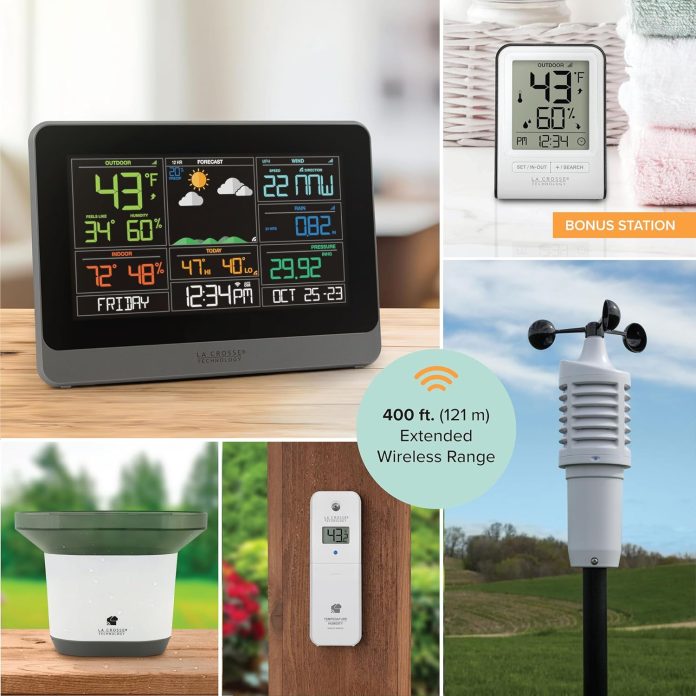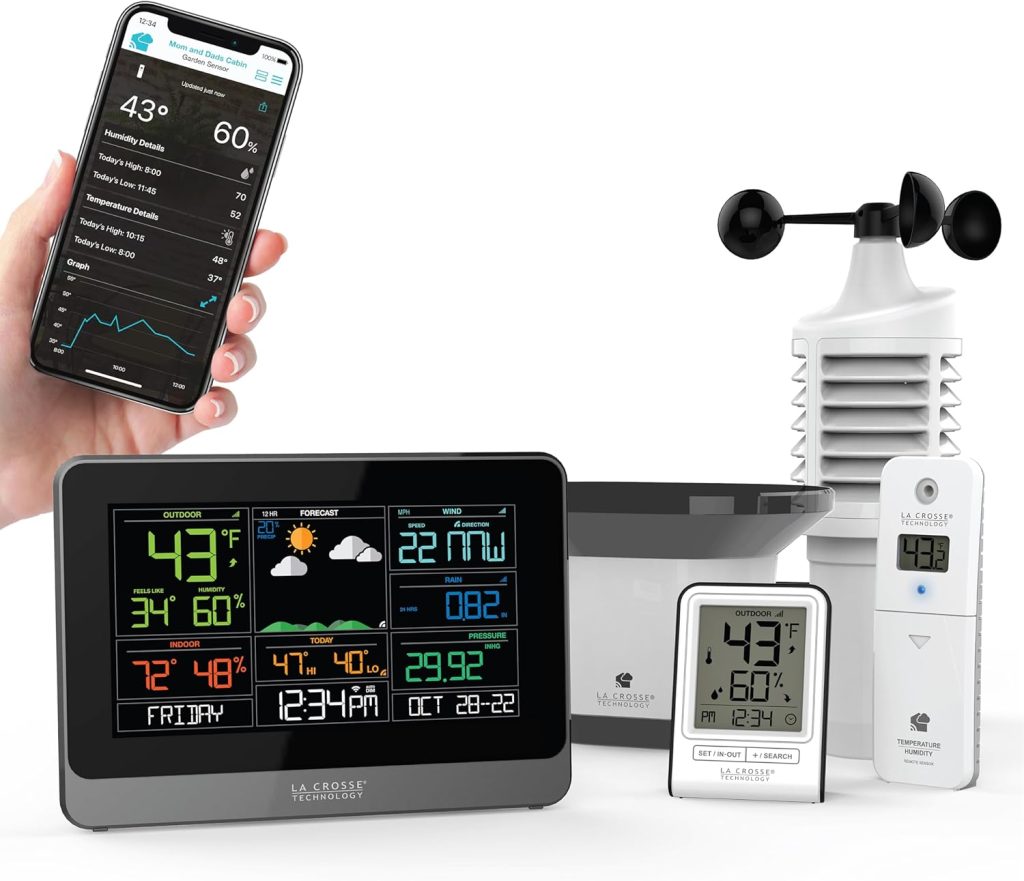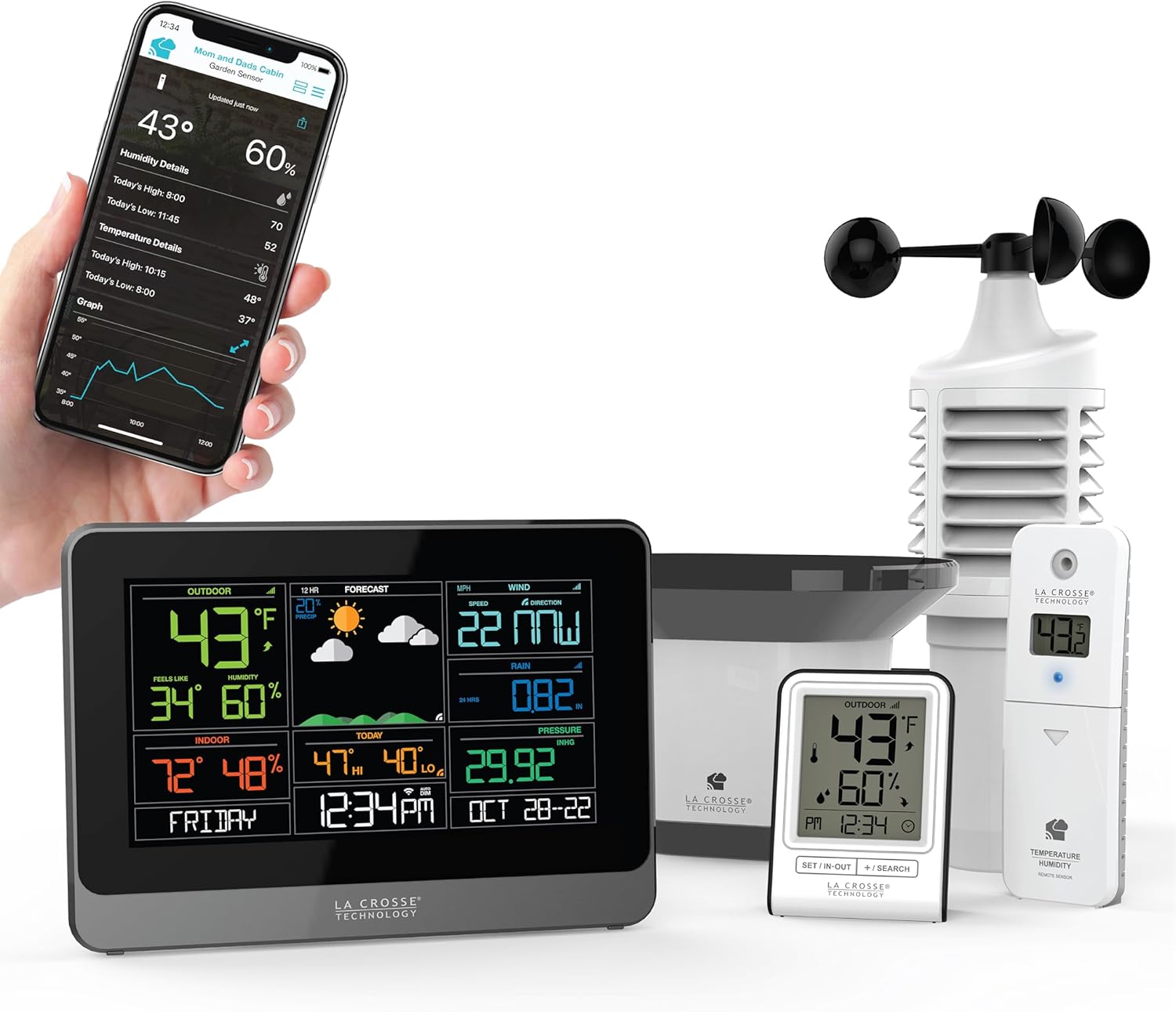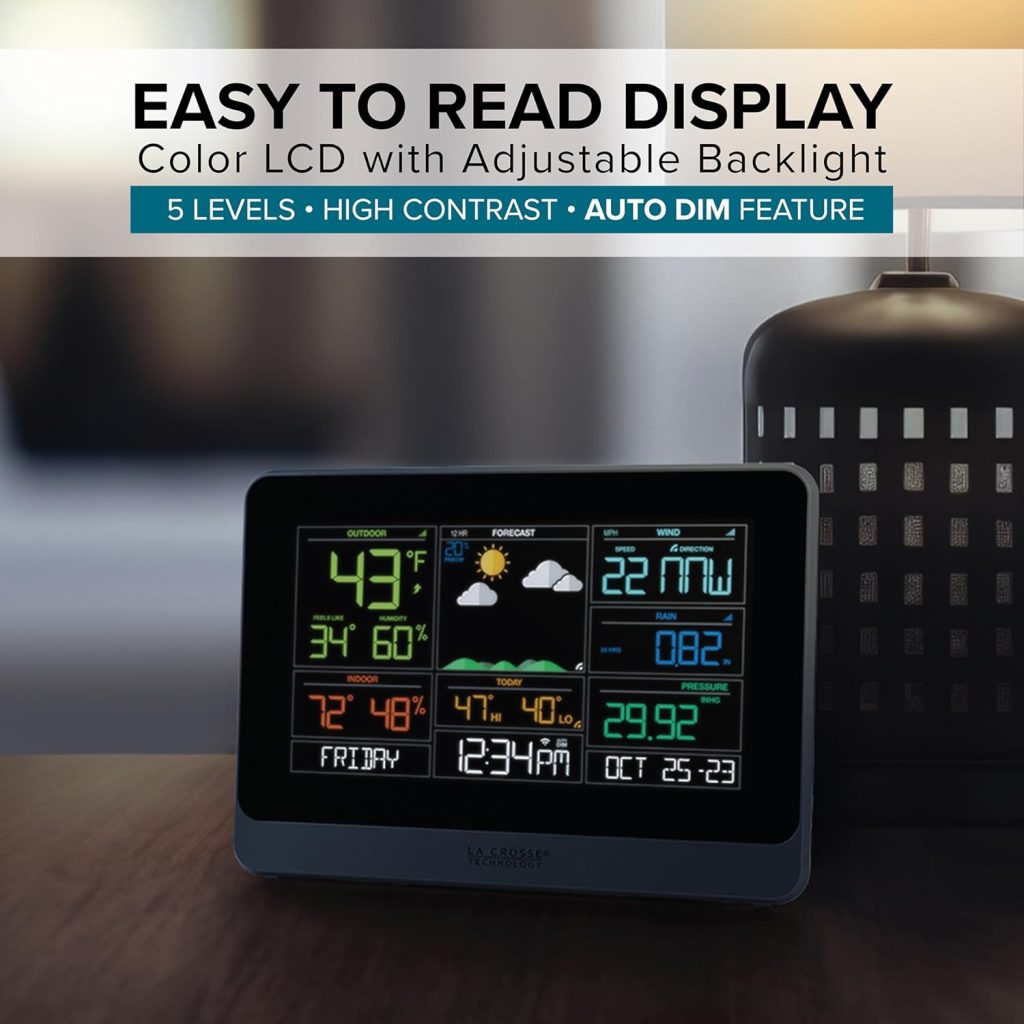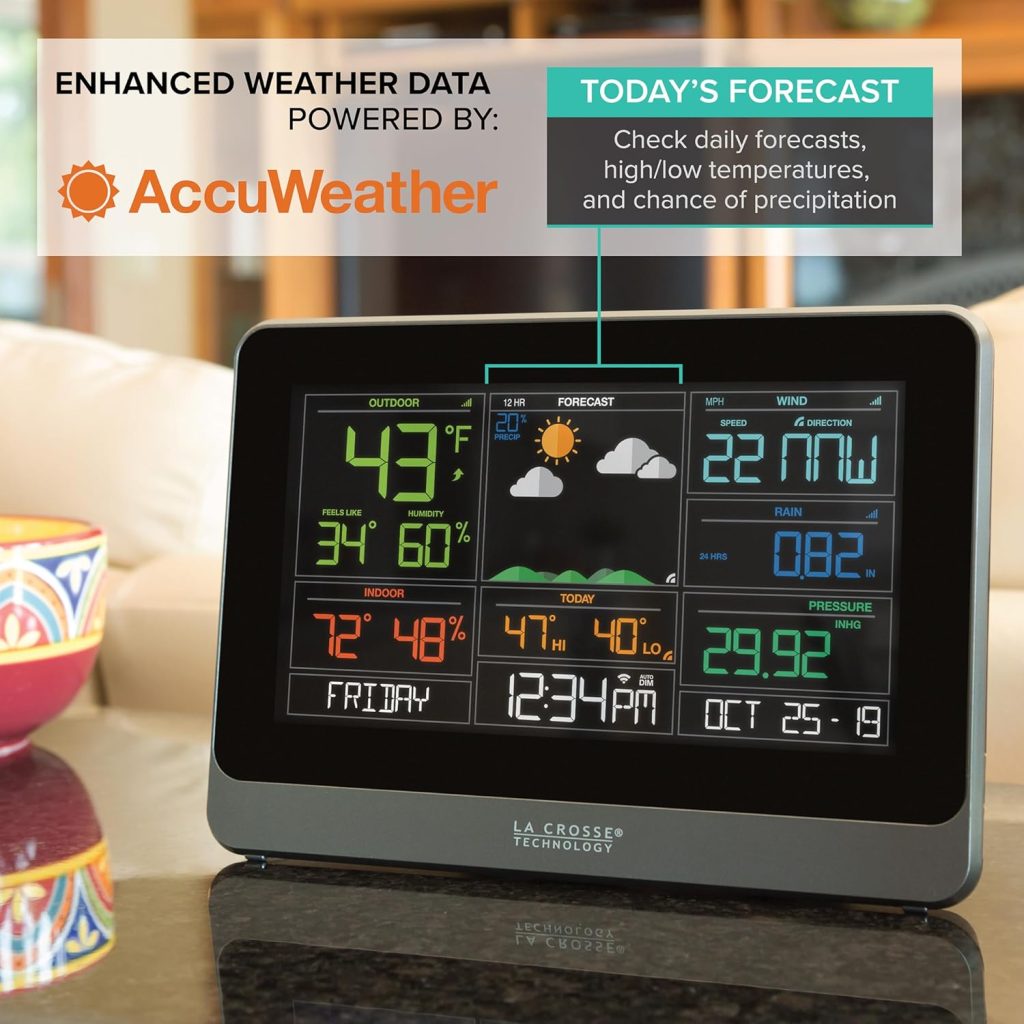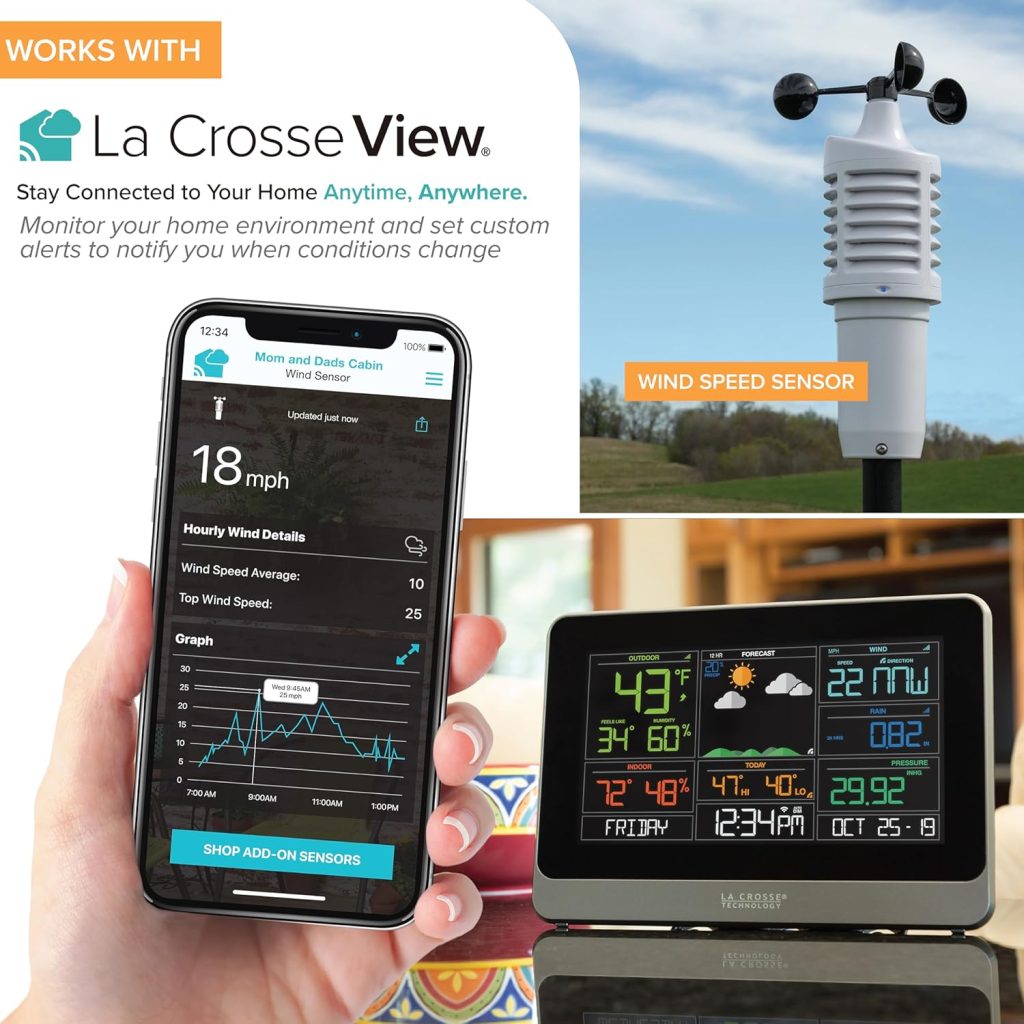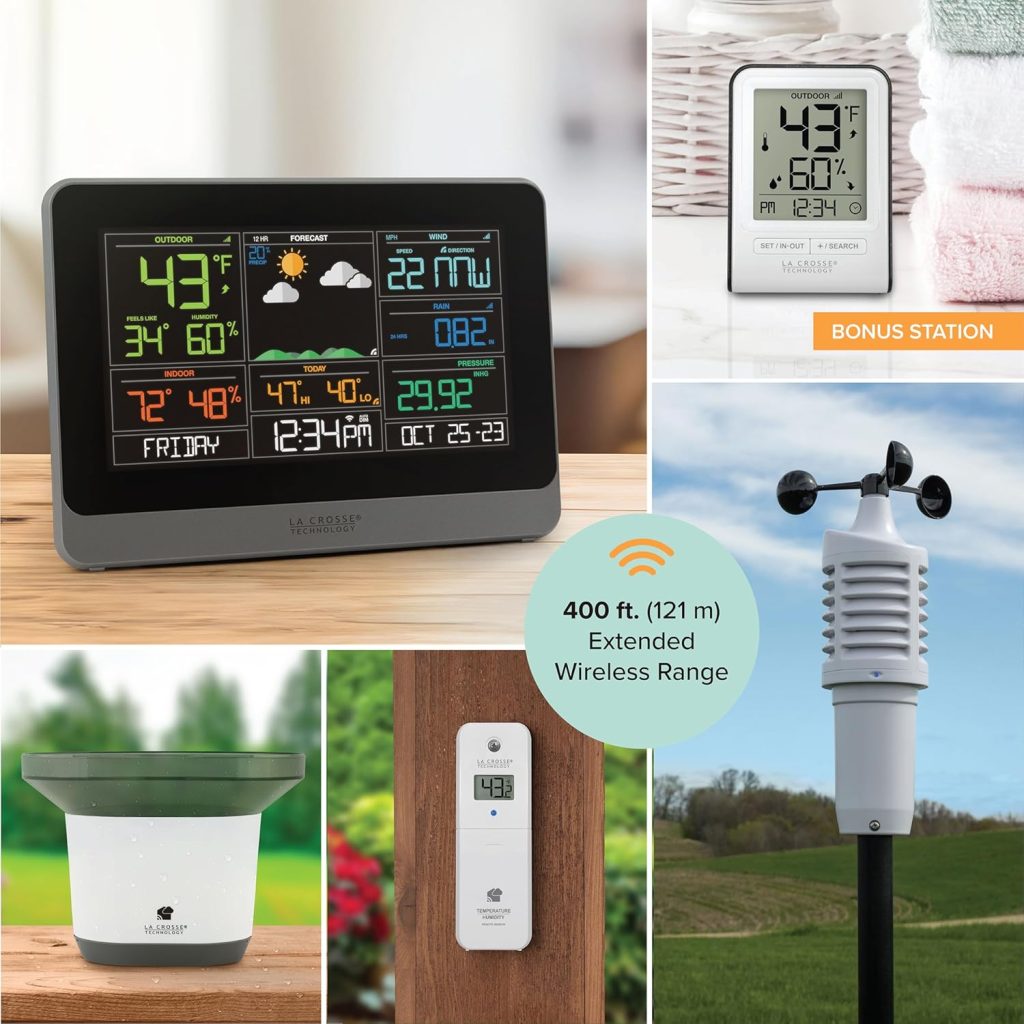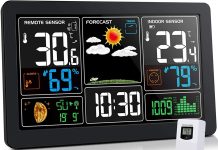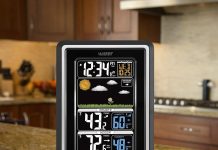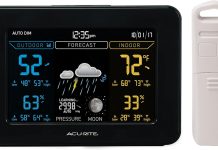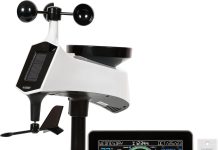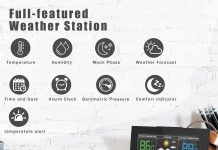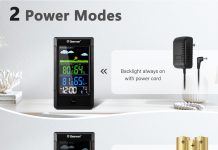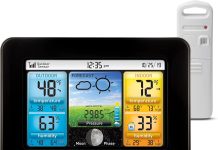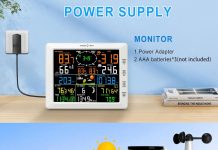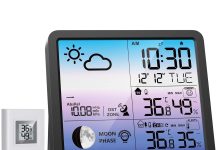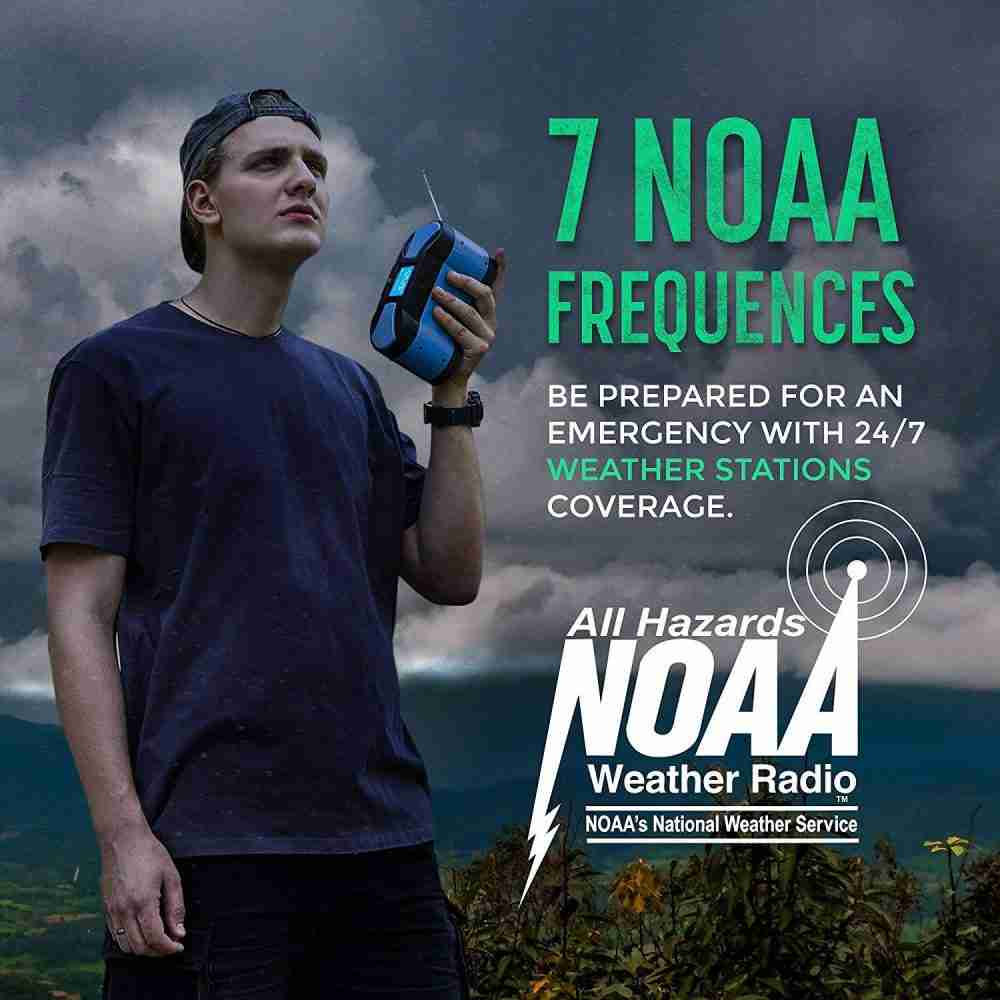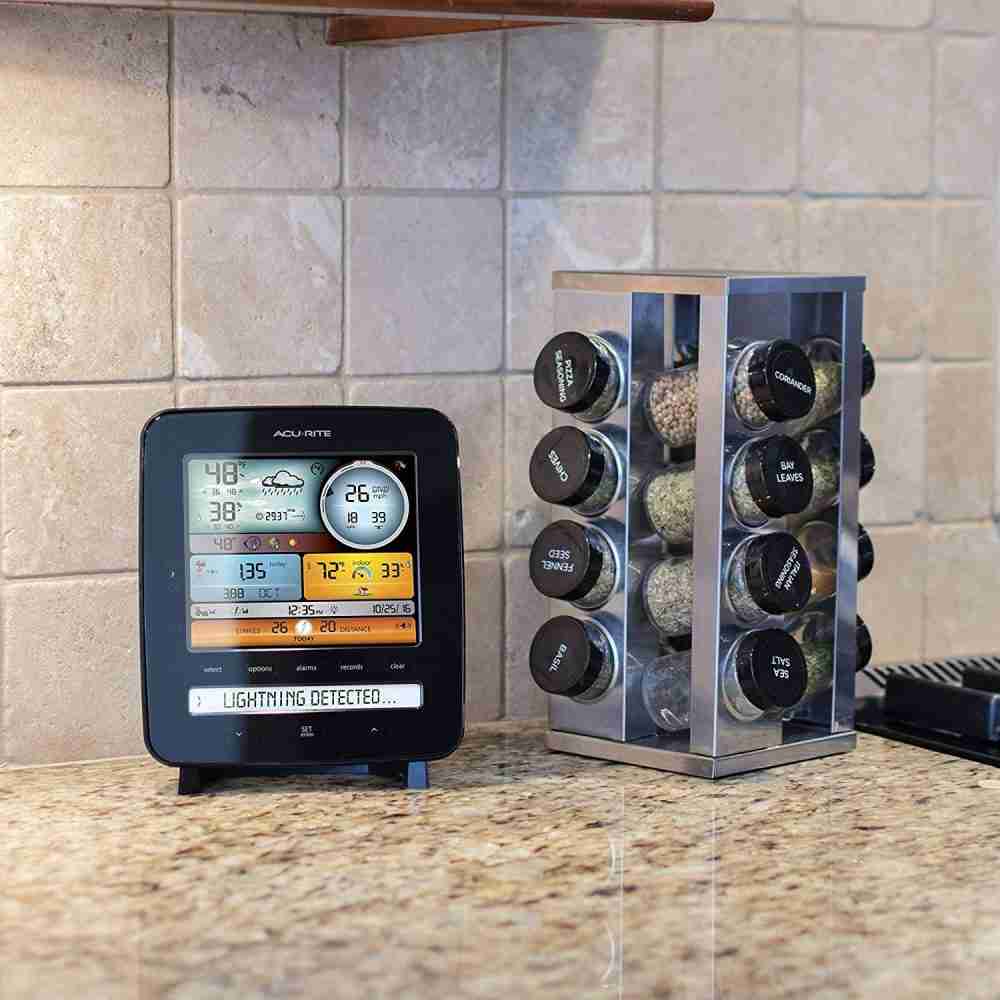Are we getting the most complete picture of our local weather with the La Crosse Technology 328-10618-INT Wireless WiFi Professional Weather Center, Black?
Overview of the La Crosse Technology 328-10618-INT Wireless WiFi Professional Weather Center, Black
We want a concise snapshot of what this system offers so we can judge whether it suits our needs. This model bundles sensors for temperature, humidity, wind speed, and rainfall with a color LCD console and optional Wi-Fi connectivity for enhanced remote monitoring.
What’s included and how the package feels out of the box
We find the package to be straightforward and modular, with clearly labeled components that make initial setup less intimidating. The console, thermo-hygro sensor, self-draining rain bucket, and the LTV-W1 wind sensor are the main pieces, and the build quality feels solid for consumer-grade weather gear.
Core selling points
We like that the system provides both immediate display feedback and the option to connect to the La Crosse View app for remote access, alerts, and historical data. The 400-foot wireless sensor range, AccuWeather integration (via Wi-Fi), and expandable sensor support make this unit appealing for hobbyist meteorologists and homeowners alike.
La Crosse Technology 328-10618-INT Wireless WiFi Professional Weather Center, Black
Design and build quality
We appreciate devices that look good on our porch and last through seasons. The console is finished in black with a clear LCD that shows color weather forecast icons and seasonal foliage changes, while the sensors are rugged enough for typical outdoor exposure.
Console and display
We find the LCD color icons easy to read from a short distance, and the seasonal foliage visuals add a friendly touch to the display. The console is compact and readable at a glance, although visibility in very bright sunlight can be somewhat reduced compared to high-contrast monochrome displays.
Sensors and hardware
We’re impressed by the practical design of the sensors, including the self-draining rain bucket that reduces the need for manual clearing. The wind sensor uses the LTV-W1 unit which requires 2 C batteries, while the rain bucket needs 2 AA batteries and the console itself requires 2 AA batteries.
Connectivity and app features
We value systems that let us check conditions when we’re away from home and that integrate with mobile tools. Connecting the console to our 2.4GHz Wi-Fi network enables the La Crosse View app features, AccuWeather forecasts, remote monitoring, alerts, and data sharing.
La Crosse View app capabilities
We can monitor live readings, set custom alerts for temperature and humidity, view historical data, and share weather information through the La Crosse View app. The app is compatible with iOS and Android devices and helps us receive notifications when preset thresholds are crossed.
Wi‑Fi setup and requirements
We recommend verifying that your home network supports 2.4GHz, because the system won’t connect to 5GHz-only networks. The setup through the app is generally straightforward, but we suggest keeping the console near the router for initial pairing and then relocating as needed.
Performance and accuracy
We want reliable data that reflects local microclimates, especially when protecting plants or monitoring a backyard weather station. The thermo-hygro sensor gives good indoor/outdoor readings, and wind/rain measurements are consistent with expectations for a consumer-level weather station.
Temperature and humidity tracking
We find the thermometer and hygrometer to be accurate enough for gardening and basic weather awareness, and the app’s custom alerts help protect plants by warning about high/low temperatures. For highly precise scientific measurement, we’d recommend calibrated reference instruments, but for household use this system performs well.
Wind and rainfall measurements
We’ve observed that the LTV-W1 wind sensor responds quickly to gusts and that the self-draining rain bucket provides reliable cumulative rainfall totals. The system records hourly, daily, weekly, monthly, and yearly rainfall totals which is hugely useful for tracking seasonal precipitation patterns.
Data logging and history
We like the ability to look back at trends instead of only seeing current conditions. The console stores historical values and the app retains longer-term records, allowing us to review temperature swings and rainfall totals across different time scales.
Types of historical data available
We can check hourly, daily, weekly, monthly, and yearly totals for rainfall, and view temperature and humidity trends alongside wind histories. Having these multiple intervals helps us analyze patterns relevant to gardening, outdoor projects, and general planning.
Exporting and sharing data
We appreciate that the La Crosse View app lets us share weather info and possibly export data for further analysis through screenshots or app-based sharing. While it’s not a full-featured export system for advanced meteorological research, it’s more than enough for community sharing and personal records.
Installation and setup guide
We prefer straightforward, step-by-step instructions to avoid endless trial and error. Below we list a practical setup order and tips that helped us get the system online quickly.
Step-by-step setup recommendations
We recommend starting by inserting batteries into each sensor and the console, placing the console near the router for initial Wi-Fi setup, and then opening the La Crosse View app to follow the on-screen pairing instructions. After successful pairing, we move the sensors to their recommended outdoor positions and verify that readings are stable.
Sensor placement tips
We advise placing the thermo-hygro sensor in a shaded, ventilated spot away from direct sunlight and heat sources for accurate temperature and humidity readings. For the rain bucket, choose a clear, level location free from overhangs; for the wind sensor, mount it high and clear of obstructions for better gust detection.
Expandability and compatibility
We like products that allow growth as our needs change. This system supports additional La Crosse sensors, so we can expand monitoring with more thermo-hygro sensors, soil sensors, or additional anemometers if we want more localized readings around our property.
Adding extra sensors
We found the console to be capable of handling multiple external sensors, which is handy for monitoring different zones like a greenhouse and a backyard. Adding sensors can increase the system’s usefulness if we want to compare microclimates or monitor specific areas regularly.
Integration with other services
We appreciate that Wi-Fi connectivity brings AccuWeather forecasts into the console, providing local temperature and precipitation predictions. Beyond AccuWeather, our options for third-party integrations are limited compared to open-source or enthusiast-focused platforms, but the core app experience is solid.
Battery life and power considerations
We prefer low-maintenance devices that won’t have us climbing ladders every week to change batteries. The sensors run on common battery sizes and the system is designed to balance performance with reasonable battery life.
Battery types and expected replacement frequency
We note that the console requires 2 AA batteries, the rain bucket needs 2 AA batteries, and the LTV-W1 wind sensor uses 2 C batteries. Actual battery life varies with reporting frequency and temperature extremes, but replacing seasonal batteries annually is a reasonable plan for many users.
Power optimization tips
We found that reducing reporting frequency (if adjustable), using high-quality alkaline batteries, and placing sensors in moderate temperature locations can extend battery life. For those using the system in very cold climates, lithium batteries may offer longer life and better cold-weather performance.
User experience: console vs app
We value both a clear on-site display and a robust mobile interface. The console gives us at-a-glance forecasts and readings while the La Crosse View app adds history, alerts, and remote access that make the system more flexible.
Console usability
We find the color icons and seasonal foliage graphics on the LCD to be engaging and useful for quick checks. Navigation is intuitive enough for most users, though some may prefer the app for deeper data review.
App usability and notifications
We like the app’s push notification options, which let us set temperature and humidity alerts to protect plants or pipes. The app layout is straightforward, and syncing tends to be reliable once the Wi-Fi link is stable.
Comparison with similar products
We want to know whether this station outshines comparable units in reliability, features, and value. Compared to many consumer weather stations, the La Crosse Technology 328-10618-INT stands out for Wi-Fi connectivity, color icons, and expandable sensors at a mid-range price point.
How it stacks up feature-wise
We see that this model’s combination of indoor/outdoor sensors, wind and rain measurement, 400-foot wireless range, and app integration places it above basic single-sensor units. However, professional-grade weather stations with higher sensor precision and more advanced data export options still outperform it for scientific applications.
Strengths vs weaknesses relative to competitors
We find its strengths in ease of use, app features, and modular expandability, while potential weaknesses include limited third-party integrations and the reliance on a 2.4GHz Wi-Fi band. For most home users, the pros outweigh the cons, but enthusiasts who want full integration with platforms like Home Assistant might look for more developer-friendly options.
Pros and cons
We prefer balanced assessments that highlight both benefits and limitations so we can make informed decisions. Below are the main advantages and disadvantages we observed.
Pros
- We enjoy the clear LCD with color icons and seasonal foliage visuals for quick at-a-glance updates.
- The 400-foot wireless range and modular sensor approach let us tailor monitoring across our property.
- Wi-Fi and La Crosse View app support remote monitoring, alerts, and historical data tracking.
- The system integrates AccuWeather forecasts for enhanced predictive info.
- Batteries are standard sizes, keeping replacements simple and inexpensive.
Cons
- We notice visibility can be challenged in very bright sunlight or from long distances compared to larger displays.
- The system requires a 2.4GHz Wi-Fi network and won’t connect to 5GHz-only setups, which may confuse some users.
- Third-party smart home integrations are limited, which could disappoint advanced users who want broader automation options.
- For highly precise scientific monitoring, the sensors are adequate but not top-tier.
Maintenance and care
We like products that are easy to maintain and weather-resistant enough to survive regular exposure. With seasonal checks, battery replacements, and occasional cleaning, this system stays reliable for years.
Routine maintenance tasks
We recommend checking battery levels at least twice a year, cleaning the rain bucket occasionally to prevent build-up, and confirming that sensor mounts remain secure after storms. These simple steps keep readings accurate and prevent downtime.
Troubleshooting common issues
We found that weak or dropped readings often trace back to low batteries, interference from obstacles, or the console being too far from sensors. Rebooting the console, replacing batteries, and ensuring clear line-of-sight between sensors and console can solve most common issues.
Who should buy this?
We think this unit is a great fit for homeowners, gardeners, hobby meteorologists, and small hobby farms who want reliable local weather information. If we want straightforward installation, remote monitoring via an app, and the flexibility to add sensors later, this is a strong choice.
Use cases that benefit most
We recommend this system for people monitoring garden conditions, protecting outdoor plants from frost, tracking rainfall for irrigation planning, or satisfying general curiosity about their property’s microclimate. It’s also helpful for casual data collection and sharing with friends or community garden groups.
Situations where to consider alternatives
We advise considering alternatives if we need professional-grade instrumentation for research, high-frequency data exports to open platforms, or native integrations with certain smart home ecosystems. Serious weather hobbyists who need advanced scripting and local integrations might look at more customizable solutions.
Price and value
We look for a balance between what we pay and what we get, and this station often sits in a mid-range price category. Considering the bundled sensors, app features, and expandability, we feel the La Crosse Technology 328-10618-INT offers good value for most residential users.
Long-term value considerations
We believe the ability to add sensors later and the inclusion of AccuWeather forecasts through Wi-Fi increase the long-term usefulness of the system. Replacing batteries annually and performing simple maintenance keeps ownership costs low.
Table: Quick specifications and user-friendly summary
We put the key details into a table to make comparison and reference easy. This gives us a handy snapshot to decide on suitability.
| Feature | Specification / Notes |
|---|---|
| Product Name | La Crosse Technology 328-10618-INT Wireless WiFi Professional Weather Center, Black |
| Wireless Range | Up to 400 feet (clear line of sight) |
| Sensors Included | Thermo-hygro sensor, LTV-W1 wind sensor, self-draining rain bucket |
| Console Display | Color LCD with weather forecast icons and seasonal foliage |
| Wi-Fi | 2.4GHz required; connects to La Crosse View app |
| App Compatibility | iOS and Android (La Crosse View) |
| Remote Features | Monitor remotely, set alerts, check history, share data |
| Data Recording | Hourly, daily, weekly, monthly, yearly totals (rainfall and other records) |
| Batteries – Console | 2 AA (required) |
| Batteries – Rain Bucket | 2 AA |
| Batteries – Wind Sensor (LTV-W1) | 2 C |
| Expandability | Supports additional La Crosse sensors |
| Forecast Integration | AccuWeather local forecasts via Wi-Fi |
| Typical Use Cases | Home gardening, backyard weather monitoring, basic hobbyist use |
Tips to get the most accurate readings
We want our data to be as accurate as possible without unnecessary complexity. These practical tips improved our results.
Placement and orientation tips
We recommend placing temperature/humidity sensors in shaded, ventilated areas and mounting the wind sensor high and unobstructed for better readings. For rainfall, pick a level, clear spot away from gutters and tree canopies to avoid under- or over-reporting.
Calibration and validation tips
We advise periodically cross-checking temperatures with a calibrated thermometer and comparing rainfall totals with a simple manual gauge after heavy events. Small offsets are normal; if we see large persistent differences, we should inspect sensor condition and mounting.
Troubleshooting guide
We prefer to have a few troubleshooting steps at hand before calling support. The following steps solved most minor issues we encountered.
Common problem solutions
If readings stop updating, first replace the batteries and ensure sensors are firmly seated and unobstructed. If Wi-Fi synchronization fails, verify the network is 2.4GHz, restart the console and router, and try re-pairing through the app.
When to contact support
We recommend contacting La Crosse support if a sensor is unresponsive after battery replacement, the console hardware appears damaged, or firmware/app issues persist despite troubleshooting. Keeping serial numbers and purchase information handy speeds up assistance.
Warranty and support
We like knowing what type of protection and help is available after purchase. La Crosse typically offers standard manufacturer warranties and online support resources for setup and troubleshooting.
What to expect from warranty coverage
We expect the unit to be covered under a limited warranty against manufacturer defects for a specified period, which varies by retailer and region. We advise registering the product if possible and keeping proof of purchase to facilitate any warranty claim.
Support resources
We found helpful user manuals, FAQs, and app guides on La Crosse’s website, and community forums can also offer tips from other owners. If a hardware issue arises, customer support is the next step for replacements or repairs.
Final verdict
We feel the La Crosse Technology 328-10618-INT Wireless WiFi Professional Weather Center, Black, strikes a strong balance between ease of use, functionality, and expandability. For home weather monitoring, garden protection, and casual meteorological interest, this system provides reliable readings, useful app features, and a friendly display that makes weather tracking enjoyable.
Our recommendation summary
We recommend this product for anyone who wants a capable, app-connected weather station with wind and rainfall monitoring, clear display icons, and the ability to grow the system with extra sensors. If our priorities include advanced data export, professional sensor precision, or complex smart home integrations, we might consider other specialized options, but for most household needs this unit is an excellent choice.
Frequently asked questions (FAQ)
We gathered some common questions and practical answers to help us and others decide quickly.
Can the system work without Wi‑Fi?
Yes, the console functions standalone and displays local sensor readings and forecasts based on its own inputs. Wi-Fi is only required for remote monitoring, app features, and AccuWeather integration.
What Wi‑Fi frequency does it support?
The system requires a 2.4GHz Wi-Fi network and will not connect to 5GHz-only networks. Ensure your router broadcasts a 2.4GHz SSID or has dual-band support enabled.
How many additional sensors can we add?
The console supports additional La Crosse sensors, though the exact number depends on the model’s channel capacity. We suggest checking the manual for the maximum supported sensor count to plan any expansion.
How accurate are the measurements?
For residential and gardening purposes, accuracy is good and consistent, though it won’t match high-end research-grade instruments. Calibration checks and proper placement improve consistency and reduce measurement error.
Are replacement parts easy to find?
We found replacement rain buckets, wind sensors, and thermo-hygro sensors available through La Crosse and third-party retailers. Batteries use common sizes (AA and C), which keeps ongoing maintenance low-cost and simple.
If you’d like, we can walk through a personalized setup plan for your property or recommend specific mounting locations and reporting intervals to optimize performance.
Disclosure: As an Amazon Associate, I earn from qualifying purchases.

